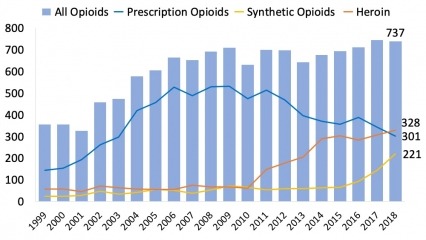Synthetic Opioids in Washington State
We have discussed Washington’s opioid epidemic multiple times on the Lakeside-Milam blog, and for good reason. The rising popularity of synthetic opioids – primarily fentanyl – has resulted in a soaring rate of fatal overdoses in the Evergreen State.
The National Institute on Drug Abuse (NIDA) regularly collects data about fatalities and substance use throughout the country. In 2018, the organization found that an estimated 63 percent of fatal drug overdoses in Washington involved opioids.
- Heroin and prescription opioids: Opioid-involved deaths remained steady in 2018 (Of more than 700 total deaths, 328 could be attributed to prescription drugs and 301 were caused by heroin).
- Synthetic opioids: 2018 saw a significant increase in fatal overdoses involving fentanyl and fentanyl analogs – this number rose to 221 deaths.
The chart below, reproduced from the NIDA website, illustrates the sharp increase in overdose deaths attributed to synthetic opioids.

Chart: NIDA
What is Fentanyl?
Fentanyl is a synthetic opioid: a potent drug created in a lab for the purpose of pain relief. Originally popularized as a pain management approach for terminally ill cancer patients in the 20th century, fentanyl is up to 100 times stronger than morphine. At first, drug dealers acquired this medicine through diversion. This term refers to the process of transferring medication away from the person to whom it was prescribed or the institution in which it is housed.
Common diversions for fentanyl originally included:
- Illicit distribution by physicians, pharmacists, and patients
- Fraudulent and forged descriptions
- Theft
The most well-known brand names for fentanyl are:
- Actiq – a lollipop-like lozenge
- Duragesic – a transdermal patch created in the 1990s
- Subsys – a drug sprayed under the tongue
- Lazanda – a nasal spray
- Abstral – a dissolving sublingual tablet
- Sublimaze – an injectable form of the drug used in hospitals
However, beginning in the mid-2000s, the Drug Enforcement Administration (DEA) noted an outbreak of fentanyl overdoses. Surveillance revealed that these deaths were localized and could reasonably be attributed to clandestine labs. This meant that individuals had gained the ability to manufacture their own fentanyl, rather than rely on the diversion tactics listed above. This availability resulted in an increased supply of the drug, which in turn lowered its price and increased its popularity as a “filler.”
Effects of fentanyl include:
- Pain relief
- Seizures
- Dizziness and blurred vision
- Slowed breathing
- Headaches
- Itching
- Constipation
- Drowsiness
In addition to the above effects, fentanyl is widely abused due to its powerful euphoric properties. This, combined with its wide availability, resulted in drug dealers “cutting” more expensive drugs with cheap-to-produce fentanyl. Therefore, those who believe that they are consuming heroin or cocaine are at risk of addiction, respiratory depression, and death.
Detox for Fentanyl
When a person decides to stop using drugs, the first step is often a medically supervised detoxification. This is commonly referred to as withdrawal management. Fentanyl detox involves stabilizing an individual, helping them to manage cravings, and alleviating the physical effects associated with withdrawal.
Symptoms of fentanyl withdrawal include:
- Chills and sweating
- Muscle aches
- Joint pain
- Runny nose and watery eyes
- Restlessness
- Stomach cramps
- Nausea and diarrhea
- Elevated blood pressure and heart rate
- Anxiety
- Insomnia
Fentanyl detox should take place in a supervised environment, preferably within an accredited Washington treatment center. Over the course of care, medical personnel prescribe medications approved by the U.S. Food and Drug Administration (FDA) to relieve opioid cravings and reduce the severity of symptoms. Over time, patients receive tapered amounts of these replacement medications through a process called medication-assisted treatment. Eventually, this reduces or eliminates one’s dependence on opioids.
Overcoming Washington’s Opioid Epidemic
As the largest treatment center in the Pacific Northwest, Lakeside-Milam has a leading role in combating the rise of synthetic opioids in Washington state. It is our belief that dependence on any substance can be overcome through evidence-based methods, including fentanyl detox, one-on-one therapies, process groups, nutritional support, medication-assisted treatment, and continuing care.
Since our opening day, we have helped more than 100,000 people to find recovery from drug addiction and alcoholism. Contact our admissions team to learn how our approach can provide hope and healing for you and your loved ones.






